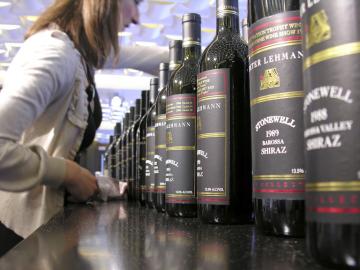Schluck, Barossa and Beethoven: 20 Years of Stonewell
POSTED ON 09/08/2009Applied together, the words living and legend should be used sparingly, but in the case of Peter Lehmann the two go as naturally together as jam and doughnuts. Described by the late Len Evans as ‘a cheerful light heavyweight with a face like a dried mudflat’, Peter Lehmann is the man who held the wine industry together at a time when the white wine revolution and vine-pull scheme of the 1980s threatened to blow the Barossa away.
A typical product of the Lutheran Barossa Deutsch culture of the era, PL, one of the few Australian winemakers instantly recognizable his his initials alone, is a fifth generation Barossan, born in Angaston in 1930, the son of a Lutheran pastor. In 1947 he joined Yalumba under Rudi Kronberger, then in 1960 Saltram, also in Angaston, where he ran the vintage from the weighbridge for 20 years as the local growers delivered their grapes and hung around for a glass of 'schluck', or Aussie port.
 growers enjoying some schluck with PL © Peter Lehmann Wines
growers enjoying some schluck with PL © Peter Lehmann Wines
In 1977, when winery owners Dalgety declined to buy the grapes because of a surplus of wine, Peter Lehmann bought them personally, made the wine and sold it off in bulk. This became impossible when spirits giant Seagram, who bought Saltram, ordered him to stop buying. Lehmann then took the biggest gamble of his life. Having honoured the contracts with his growers in the last days before Saltram was taken over, he was able to bring his grower friends together under one roof and start his own winery in 1980 with the help of Cerebos and the Anders family. Masterson Barossa Vineyards, founded on 11 November 1979, was named after Sky Masterson, the gambler in Damon Runyon’s Guys and Dolls played by Marlon Brando. Under the logo of the queen of clubs, the gambler's card, schluck and Beethoven at the weighbridge became part of the annual harvest ritual.

The vine-pull scheme of the mid 1980s, designed to remove unfashionable varieties, was a low point for the Barossa. It did its job of removing unloved varieties like doradillo and palomino, but it also did irreparable damage to the Barossa’s stock of old vine grenache. Nevertheless, demand for Barossa shiraz grew towards the end of the decade and Peter Lehmann decided to seize the opportunity provided by its then owners MS McLeod Holdings pulling out and to buy the winery. In 1993 he went public and with the money raised bought a number of vineyards, including Stonewell. More recently, Peter Lehmann was sold to Hess Family Estates, the group belonging to the eponymous, wine-loving Swiss businessman also comprising Hess in California, Glen Carlou in South Africa and Colomé in Argentina.
 Peter Lehmann © Peter Lehmann wines
Peter Lehmann © Peter Lehmann wines
I haven’t seen Peter Lehmann since visiting him about five years ago and enjoying coffee and his wife Margaret’s delicious strudel in their kitchen. But I did manage to catch up recently with his chief winemaker Andrew Wigan, the man who also made the first harvest at the new winery which opened for business on 10 February 1980. Wiggers, I’m pleased to say, is going strong, as are the wines he continues to make for the Peter Lehmann brand.
‘When we first started making wine at Peter Lehmann in 1980, we only made one shiraz. But we know that the shiraz that came from some vineyards was better than others – more intense, more muscular, and deeper in colour. We’d seen it in the vineyards. “Little black jewels” we called them’, says Andrew Wigan. ‘Peter and I couldn’t keep our minds off those special parcels of grapes, so in 1987 we made a separate shiraz. We called it Stonewell, after the district that we believed showed the characters we admired in the best of Barossa shiraz’.
Andrew Wigan’s words were an elegant prelude to 20 Years of Stonewell, a tasting he hosted this summer at the ANdAZ Hotel. Peter Lehmann’s experienced chief winemaker showed every single year of Stonewell, from its inception in 1987, right up to the present-day 2006. Of the 185 independent growers on whom Peter Lehmann relies for its grape supplies, each year a selection is made from a handful of the best growers’ vineyards to go into Stonewell.
 Andrew Wigan
Andrew Wigan
The Stonewell shiraz book publishes a list of all the growers who supplied each vintage, so you learn for instance that only 3 growers supplied grapes for the inaugural vintage, Ralph Schrapel, Roy Seelger and Peter Scholz. These and many of their colleagues, like Peter Lehmann himself, are descendants of the Silesian refugees who emigrated to Australia in the mid-19th century to escape religious persecution by King Friedrich Wilhelm III of Prussia. The list reads like the honours board at the Adelaide Oval, with Ralph Scrapel, the Don Bradman of growers, almost always present, while others come and go. Schrapel heads the list with 12 of the 20 Stonewell vintages, while Ron Adriske comes in second with 11, Bob Burdon 10, and Ian Becker and Wayne and Shirley Standish 9 each.
 Stonewell
Stonewell
For over 150 years, shiraz has been the major variety in a region discovered by Colonel William Light, South Australia's First Surveyor-General, in 1837. With 12,500 hectares of vineyards spread over eight soil types today, the Barossa Valley enjoys a Mediterranean climate with warm dry summers and cool winters. The eight major soil types here vary from red brown earths, alluvial soils, sand over clay, deep sands, dark brown cracking clays, skeletal soils, podzolic and solodic soils.
In general, it’s fair to say that the style changes in the mid-1990s once the switch from American to French oak begins. It starts in 1996 with 10% French oak and by 1998 Andrew Wigan is already using 70% French oak. At the same time, the alcohol rises from around 13% (only 12.5% in the case of the 1990) to 14.5%, which, while powerful, never reaches the level of some of the alcoholic monsters coming out of the Barossa and McLaren Vale, seemingly so dear to the American palate. According to Andrew Wigan, this isn’t a function of climate change but part of a deliberate decision to ‘get better texture and more colour, with richer and softer tannins’.
20 Years Tasting
1987
Garnet in colour, with mint and ginger undertones present along with tarry leathery aromas, this comes across like a gran reserve Rioja, sweet and soft with chocolatey notes easy tannins and savoury acidity. 13% alcohol, drink now. 88
1988
A more youthful garnet colour, there’s game and leathery characters in the aromatic profile, livelier and sweeter than the 1987 and still going strong – just about – with supple tannins and marker savoury acidity underlying the dark fruit flavours. 13.5% alcohol, drink now for another couple of years. 89
1989
A relatively youthful garnet colour with smoky / spicy aromatic characters and distinct leather armchair background tones plus a touch of the pepper grinder to go with the sweet mint and dark plum and prune fruitiness, all complemented by firmish tannins. 13.5% alcohol, drink now and for 5 years. 90
1990
With a touch of ruby in this garnet-coloured red, it looks quite youthful, the nose gives off notes of mint, autumn bonfire smoke and spice, again a another evolved red whose leathery undertones suggest gran reserva Rioja only perhaps a little bit more opulent with fine dark fruits, succulent tannins and savoury acidity. 12.5% alcohol. Drink now and for another 7 years. 90
 Andrew Wigan
Andrew Wigan
1991
Just as the 1990 and 1991 Penfolds Grange make a fascinating pair, with many now preferring the underrated 1991 after the initial view that the 1990 was superior, the 1991 here is a terrific red. Deep in youthful garnet hue, it has a beautifully evolved scent of mint and liquorice spice with touches of charrry smoke and vanilla, while the fine concentrated richness of fruit on the palate is suffused with blackcurrant jam and spice and a continuation of the smoky oak char on the nose. 13% alcohol. Drink now for another 7 years. 93
1992
Showing a substantial youthful ruby colour with only a touch of garnet, this is still very youthful, with stylish cedary and cigar-box-like perfumes plus a touch of mint and pepper, while the vibrancy of concentrated dark fruits sweetness, beautifully evolved and softened now, is complemented by chocolatey undertones; just about ready for drinking, a firmish tanninc backbone suggests a life of a good 7 years, ahead of it. 13.5% alcohol. Drink now and for 7 years. 92
1993
A youthful ruby garnet in colour and with undertones of pepper, dark fruits and mint on the nose, there’s plenty of concentrated sweet blackberry and prune fruitiness to coat the palate and fill the mouth with richness of flavour with background notes of bittersweet chocolate underscored by the charry smokiness of American oak, all in all coming across nicely balanced and still quite firm on the finish. 14% alcohol. Drink now and for 7 years. 92
1994
This is the most youthful of the bunch to date with quite a lot of ruby in the colour still, while the nose boasts scents of chocolate, prune, liquorice and cinnamon spiciness; the palate here is deliciously rich and sweet with plum and blackberry fruit, tinged with mint and the vanillan / smoky char of American oak. Still vigorous, muscular and youthful, it’s finely balance with lovely polished fine-grained tannins. 13.5% alcohol. Drink now for seven to 10 years. 93
1995
Vivid in colour with intense sweet smoky char, cedar and vanilla on the nose, this has an extremely attractive richness of dark berry fruit such as mulberry and blackberry with typical spice and charry undertow and a firm backbone of tannin that’s starting to show some dryness. 13.5% alcohol. Drink now for 7 years. 90
1996
10% French oak hogsheads used for the first time in the fermentation of Stonewell marks the beginning of a new era, which, assisted by an excellent vintage, brings intense pepper and spice to the black fruit scents of Stonewell, a wine with lovely classic, dark-hearted shiraz fruit concentration, tinged with mint, pontefract cake and dark chocolate , all bound up in a framework of fine acidity and tannins. 14% alcohol. Drink now and for 10 years plus. 94
1997
Showing ruby shading to evolved garnet tones, this is quite pruney on the nose and a little bit hot, the fruit of dark chocolate and prune sweet and ripe with soft, approachable tannins and while very drinkable now; this is somewhat overshadowed by the class and concentration of the previous vintage (and the next). 40% French oak used here. 14% alcohol. Drink now and for 5 years. 89
1998
A vivid youthful ruby, with 70% French oak, this wine looks and smells as though it’s barely ready for drinking even though over 10 years old now. Densely coloured, the aromas are intense showing liquorice spice, cedary, dark fruits and chocolate, the palate immensely rich and almost sweet with a lovely pepper-tinged black fruited shiraz purity of texture and flavour and firm backbone giving the structure for ageing for a good decade and longer. 14.5% alcohol. Drink now and for 15 years. 5000 cases made. 95
1999
Although the colour is still good, and relatively youthful, the nose is somewhat weak after the last vintage’s intensity, while the palate, showing some vanilla oak char, spice and dark red fruits characters, is showing too much in the way of dry tannins to suggest any further development. 14% alcohol. Drink now and for two years. 87
2000
Deep in colour, this has the classic savoury-tarry aromas of syrah more than shiraz with lots of prune, pepper and tar, while the palate shows plum / prune, dark chocolatey flesh and richness , a ‘fruit bomb’ with slightly drying tannins on the finish . 14.5% alcohol. Drink now and for 5 – 7 years. 91
2001
Relatively pale and evolved in colour compared to those either side of this vintage, this shows attractive plum and prune scents and flavours with some vanilla and liquorice spicy oak, while the palate is plumped out with dark berry fruits and chocolatey undertones, appealing fleshy fruit with some firm, drying tannins on the finish. 14.5% alcohol. Drink now and for 5 – 7 years. 89
2002
From the coolest vintage on record in the Barossa, this is inky dense black in colour, with lifted peppermint plum and spice aromas, while the palate is incredibly intensely flavoured and concentrated, showing powerful dark berry fruits flavours tinged with spice, mint and chocolatey richness, while the firm, almost solid backbone and complementing acidity suggests that this is barely into its stride and has a good 15 years life ahead of it, maybe more. 14.5% alcohol. Drink now’ish and for 15 years. 5000 cases made. 96
2003
This seems rather dull, solid and four-square by comparison with the best we’ve seen so far. It has an attractive enough colour and scent of vanilla oak and prune, while the palate is approachable juicy and drinkable but the whole thing seems lacking in the usual power and class. 14.5% alcohol. Drink now and for 3 years. 87
2004
Dense in youthful ruby black, there’s plenty of sweet smokiness and vanilla on the nose of this wine with good rich, ripe and opulent blackberry sweet fruit concentration and purity of flavour, with undertones of chocolate and spice, and while it’s well-crafted, it’s relatively restrained and linear compared to the best of Stonewell. Maybe needs time to show its worth as somewhat closed in at the moment. 14.5% alcohol. Drink 2010 – 2020. 93+
2005
Not released yet. This is the first Stonewell under screwcap so it’ll be interesting to see how it develops. It shows a good healthy ruby colour with a nose of bright, sweet, almost chocolatey dark berry fruits and a spicy, approachable palate of liquorice spice, black fruits tinged with pepper and fresh, savoury acidity. 14.5% alcohol. Drink now and for 7 seven years. 90
2006
Not released yet. Very dense inky dark colour and fine bright aromatic profile mingling spice, pepper and liquorice with lovely textured pure prune and blackberry fruit with undertones of bittersweet chocolate; it’s very concentrated with a glossy, almost silky rich mouthfeel despite its youth and power, a monumental, finely balanced red with a staying power that’s likely to see it go on 15 years or more once it starts drinking in a couple of years time. 14.5% alcohol. Drink 2010 – 2025. 95
For stockists of 10 selected wines, check out this month’s www.thewinegang.com report

